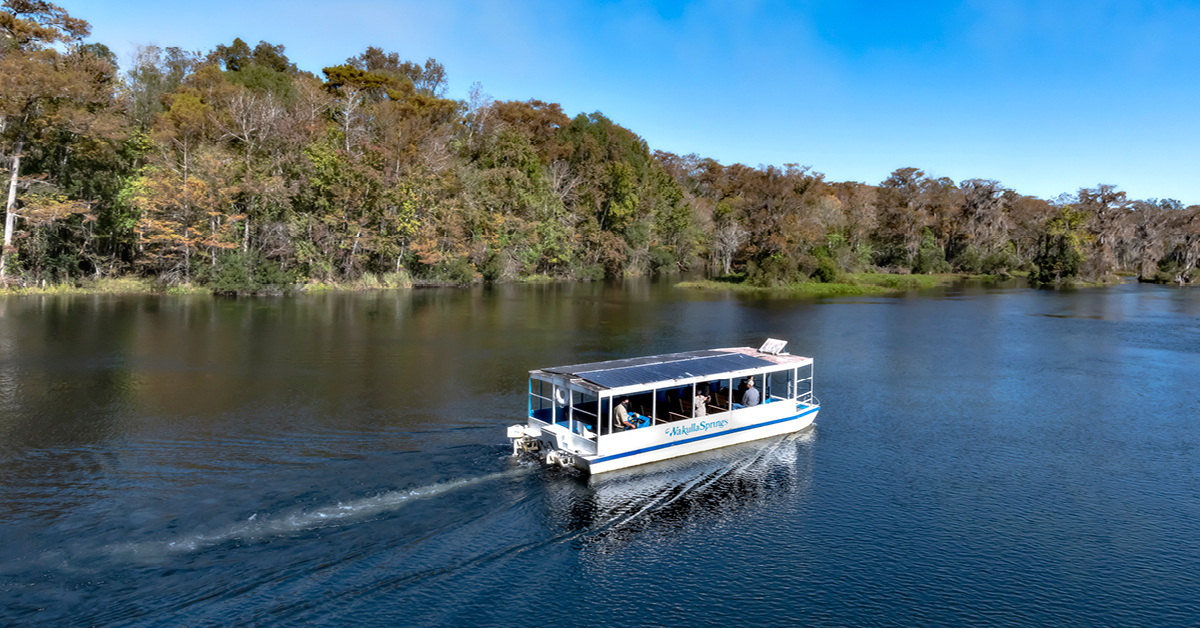Pack a Sack with Healthy Snacks for your Next Road Trip
June 2024
Top Chefs
June 2024June is peak travel season! Get ready to have fun in the sun with the endless vacation opportunities available in the summer. If you’re looking to stay closer to home, the Gulf Coast states offer an abundance of water sports, museums, and quirky activities off the beaten path. From Civil War museums to retro arcades, take a trip with Thrive through the state capitals of Deep South Dixie from Austin, Texas to Tallahassee, Fla.
Austin: An Amalgam of Arts, Culture and Nature Formations
by Kerri Cooke
Austin, Texas has been the fastest growing metro area in the United States for the last dozen years. A cultural and entrepreneurial giant in the South, Austin has innumerable options for family entertainment, even for the youngest generation.
The Thinkery is a must-see children’s museum that uses sensory stimuli to teach kids about STEAM. Ongoing exhibits include Currents, which teaches about “fluid dynamics and the connection between water and sound;” Fresh!, a pint-sized farmers’ market encouraging children to adopt healthy eating choices; Light Lab dives into topics encompassing light, shadow and color; and Our Backyard is an outdoor playground complete with an easy climbing wall and stone-filled stream.
As the largest indoor waterpark resort in America, Kalahari Resorts and Conventions holds enough entertainment options to keep the family occupied all day. The property spans 1.5 million square feet and includes dining options, spas, live entertainment, shopping and a theme park, in addition to the water park. For older children and adults, the Barreling Baboon slides are perfect for the adrenaline junkie. For younger children, Coral Cove and Tiki’s Watering Hole offer subdued water fun. At Tom Foolerys Adventure Park, families have access to laser tag, escape rooms, a mirror maze and an XD Motion theater. Parents can slip away to a halotherapy session at Spa Kalahari. Himalayan salt is dissolved into the air. The body is detoxified as the salt is inhaled.
Step back in time at the Bullock Texas State History Museum located at the Texas State Capitol. Exhibitions include Texas History Galleries, which tell the story of Texas from the time when indigenous people roamed freely to the arrival of La Salle and later the Spanish; Legacies of the Treaty of Guadalupe Hidalgo, an exhibit detailing the document that ended the U.S.-Mexico War; Texas Oil and Gas; and Becoming Texas.
Austin is a city known for its arts and culture and it is home to BookPeople, the largest independent bookstore in Texas. BookPeople has been in business since 1970, has been voted the best bookstore in Austin and boasts two floors of books with a large selection of children’s titles. Book signings are regularly held, so if you’re lucky, you might encounter famous authors such as Donna Tartt or B.J. Novak.
Pinballz is a retro-designed arcade and has the largest selection of games under one roof in the state of Texas. From traditional pinball to more modern games such as The Mandalorian, there’s enough entertainment to keep the whole family busy for hours.
Zilker Park in downtown Austin consists of 361-acres of outdoor fun. Rent a bike or canoe, have a picnic, play disk golf, and shiver in Barton Springs, a 68-degree natural swimming hole. There’s also a playground and the Zilker Zephyr Train. Nearby is Zilker Botanical Garden where visitors can experience the Taniguchi Japanese Garden, the Hartman Prehistoric Garden and the Rose Garden.
At the Austin Nature & Science Center, children learn about prehistoric animals, geology and astronomy. Dig for fossil replicas at the Dino Pit. The Naturalist Workshop invites children to inspect rocks, fossils and fur with a magnifying glass.
What would a family vacation to Texas be without taking in the beauty of horses? Texas Trail Rides offers horseback riding at Lonestar Ranch, just ten minutes from downtown Austin. Make reservations beforehand as Lonestar Ranch is a working ranch.
While there are several locations around the country, Austin is home to the closest location of The Museum of Ice Cream. Admission includes an unlimited amount of ice cream with a variety of toppings and dairy-free options. Decorated in a quirky, retro style, the museum has ample photo opportunities. Ride a giant pink animal cookie, walk through a banana tunnel and jump into a sprinkle pool. There’s also a café and bar for specialty milkshakes and cocktails.
Burgeoning Baton Rouge: A Famous Tiger, Water Park and Swamp
by Kerri Cooke
Baton Rouge is an easy, two-hour drive from Lake Charles. The city offers fabulous fun for the family right here in our home state.
The Knock Knock Children’s Museum is an outlet for younger children to play and learn. Outfitted with the Art Garden, Ship Shape Health Challenge, Storybook Climber, Paws and Claws Clinic, Pelican Pantry and more, kids acquire hands-on experience about a variety of careers and stimulate their creativity through crafting.
BREC’s Baton Rouge Zoo takes you through Africa, Asia, South America and the Atchafalaya Basin as you weave through the various trails. View alligators in a swamp exhibit, tigers in the African tundra and numerous species of birds and monkeys. At select times, visitors can feed giraffes. Part of the zoo is undergoing renovations, so pick up a map for up-to-date info.
While both the old and new state capitol buildings are open to tours, the Louisiana Old State Capitol edges out the new state capitol when it comes to architecture. With its castle-like façade and stained-glass dome, the old state capitol is beautiful to behold. Tour the House Chamber where Louisiana representatives decided to succeed from the Union in 1861. In the Senate Chamber, impeachment proceedings were initiated against former governor Huey P. Long. Rumored to be haunted, the old state capitol hosts a 4D immersive experience titled The Ghost of the Castle. Sarah Morgan, a Civil-War era figure, recounts the history of how the building was saved by locals. Other exhibits on view include Remembering the 1984 Louisiana World Exhibition and Patient No More: People with Disabilities Securing Civil Rights.
Step into history at the Capital Park Museum. Learn about famous figures from Louisiana, such as jazz legend Louis Armstrong, discover the importance of the Mississippi River for national commerce, dive into the Cajun migration, and look back on Louisiana’s Jim Crow past for a wide-ranging educational experience on Louisiana’s history.
The motto of the Louisiana Art & Science Museum is “encouraging discovery, inspiring creativity, and fostering the pursuit of knowledge.” Permanent exhibits include the Ancient Egypt Gallery (view a mummy from 300 B.C.) and the Solar System Galaxy (be amazed by images from the Hubble telescope). Admire a 65-million-year-old Triceratops skull. On exhibition through September are Improvisation: The Art & Healing Power of Jazz; Artistry and Accuracy: Botanical Illustrations by Margaret Stones; and The Art of Looking Up: Following the Stars, from Ancient Cultures to the Webb. The museum also has a kids’ lab, which teaches chemistry, and a STEAM Station.
Stoke your LSU pride with a visit to Mike the Tiger’s Habitat. One of the largest tiger habitats in the country, Mike has access to a live oak tree, comfort rock, rockwork tree, waterfall and stream, and greenery. The habitat measures 15,000 square feet and is home to Mike VII since 2017.
At the Blue Zoo, located in the Mall of Louisiana, visitors can touch and feed stingrays, reptiles and sharks; observe animal feedings; watch a pirate sword fight and meet a mermaid.
Part water park, part theme park, a visit to Blue Bayou Water Park and Dixie Landin’ is the perfect summer destination. Blue Bayou has over a dozen iterations of water slides including Lafitte’s Plunge, Flyin’ Pirogue, Mad Moccasin and Mambo. Hurricane Bay and Atchafalya Run offer a slower pace. Relax as the water gently carries you along the streams. Dixie Landin’ has the adrenaline-producing roller coaster Ragin Cajun, Cajun Collision bumper cars, Gumbo Yo Yo swings, and a traditional merry-go-round.
Visit Bluebonnet Swamp Nature Center to view hundreds of different species of bird. Deer, otters and foxes also inhabit the 103-acre nature reserve. View the natural surroundings via a mile of pathways and trek through the cypress-tupelo swamp and beach magnolia and hardwood forests. Indoor exhibits include live animal viewings, mineral displays and a vintage waterfowl decoy collection.
Once situated here in Lake Charles, the USS Kidd Veterans Museum typically resides in Louisiana’s capital city along the Mississippi River, but is currently undergoing repairs in Houma, La. For more info, visit the museum online to discover the history of and artifacts from the notorious destroyer.
Jackson: A Museum-Lovers Paradise
by Kerri Cooke
If your family loves museums, Jackson, Miss. has a museum no matter what your area of interest.
The Mississippi Museum of Natural Science is located inside Lefleur’s Bluff Playground. Children can play after trekking through the 2.5 miles of nature trails surrounding the museum. Inside the museum, find the 100,000-gallon aquarium hosting more than 200 species of aquatic wildlife. There’s an exhibit on the white-tailed deer, a fossil room and a 1,700-square foot greenhouse. Special exhibits include Dinosaurs Around the World: The Great Outdoors. Ten animatronic dinosaurs “come to life” and narrators educate visitors on what life was like for these prehistoric animals.
At the Mississippi Children’s Museum, tykes can explore exhibits such as Exploring Mississippi, which details the natural environment and history of Mississippi; Pollinator’s Playground teaches children about the roles of bees, butterflies and bats in pollination and food production; Enchanted Land of Story, a garden where children can physically experience a story; World at Work, where children can explore various careers; Wonderbox, a STEAM station; and Express Yourself, a room to engage in the arts.
Be transported back to a bustling Ag town at the 30-acre Mississippi Agriculture and Forestry Museum. The Heritage Center celebrates 500 years of Mississippi agriculture from the farming practices of the Choctaw to catfish farming. There are three model railroads on site. The National Agricultural Aviation Museum displays historic planes used to fly over farms. Small Town, Mississippi replicates a historic town that flourished on the railroad, automobile, agriculture and forestry industries. The General Store sells nostalgic items—rock candy, jacks, marbles, tops, etc., as well as local honey, jam and cheese. The Fitzgerald Collection features antiques and collectibles, while the Children’s Barnyard houses numerous small animals and a vet exhibit. The Exhibit Barn showcases historic farm equipment explains how agriculture has changed over time. The Fortenberry-Parkman Farmstead boasts original buildings from 1860. To finish the tour, walk the Nature Trail to experience the working farm.
Those who love paintings and ceramics will appreciate the Mississippi Museum of Art. Currently on exhibition are Pre-Columbian Art, featuring Peruvian pre-Columbian ceramics; New Symphony of Time, which includes artworks by famous artists reflecting on themes of migration, memory, movement and home; Thank You Please Come Again, a collection of photographs by photojournalist Kate Medley taken over a decade of exploring the South; and more.
The Mississippi Civil Rights Museum explores how the Civil Rights movement affected the state and those who lived there. Coming of Age in Mississippi by Anne Moody is an integral part of Civil Rights history as Moody witnessed the effect of Emmett Till’s murder and violence against her neighbors while being a housekeeper to a white family. Galleries include The Mississippi Freedom Struggle; Mississippi in Black and White; A Closed Society; I Question America; A Tremor in the Iceberg; Black Empowerment; and Where Do We Go From Here.
Exhibits at the Museum of Mississippi History represent the state’s journey over the past few hundred years. Cultural Crossroads: Native Americans, Europeans, and Africans 1519-1798 details the struggle over land and resources between natives and colonists; Cotton Kingdom: Enslavement and Civil War 1835-1865 explains how the cultivation of cotton and the enslavement of African Americans led to a devastating Civil War; and Promise and Peril: Progressivism, Repression and World War I 1903-1927 explores how increasing industrialization led to reform but also left some citizens stuck in the mire.
The Mississippi State Capitol is described as “an exceptional example of Beaux Arts style, vividly illustrating the nationwide spread of academic classical revival architecture of the early 20th century,” by The National Park Service. The center of government since 1903, the state capitol was designated as a Mississippi State Landmark in 1986 and a National Historic Landmark in 2016. Portraits of governors past hang in the Hall of Governors, and the main dome of the capitol hosts sculptures of Lady Justice, paintings from 1934 and an eight-foot-tall eagle. One of 55 replicas of the Liberty Bell is on the property.
A trip to Jackson wouldn’t be complete without a visit to OffBeat. Considered a destination for alternative art and apparel, OffBeats feeds into nostalgia with comic books, vinyl records, model kits, action figures and collectible pins.
Montgomery: Ground Zero for Civil Rights
by Kerri Cooke
One of Montgomery’s claims to fame is the monumental events during the Civil Rights Movement that took place there. The city’s history played a large role in changing the course of life for many African Americans. You can learn about the events at the many historical sites and museums in Montgomery.
Troy University’s Rosa Parks Museum is located in downtown Montgomery at the spot where Rosa Parks was arrested for refusing to give up her bus seat. The museum includes the original fingerprint arrest record of Parks, court and police records, a 1950s-era bus, and a 1955 station wagon like the ones used to transport protestors. The mission of the Rosa Parks Museum is to “collect, preserve and exhibit artifacts relevant to the life and lessons of Rosa Parks, the Montgomery Bus Boycott and the Civil Rights Movement.”
A National Historic Landmark, the Alabama State Capitol resides on a hill and overlooks downtown Montgomery. The capitol’s claim to fame is that delegates from states across the south voted to establish the Confederacy in the Senate chamber in 1861. Jefferson Davis was inaugurated as president of the Confederacy in the west portico. The Alabama State Capitol is part of the U.S. Civil Rights Trails as the Selma to Montgomery march ended with Martin Luther King, Jr. giving his speech outside.
Old Alabama Town is in downtown Montgomery and consists of a one-room schoolhouse, grist mill, cotton gin, log cabin and Lucas Tavern, the oldest building in Montgomery. Besides touring a building where everyday citizens worked, learned and lived, another building of note is the Ordeman-Shaw House, a rare example of a household run by urban slavery.
At Fort Toulouse Fort Jackson, view the recreated 1751 Fort Toulouse, once part of French Louisiana; Creek Indian (for which the state of Alabama was named) houses, the partially restored 1814 American Fort Jackson, which was named after Andrew Jackson’s efforts against the Creek Indians; and a 1,000-year-old Indian mound. There are regular reenactments of the Creek War in 1812 and the French and Indian war.
For the little ones, a visit to The Mooseum explains the history of Alabama’s beef industry. Learn how cows are raised and processed for consumption. There is additional information about other products created from beef byproducts. A virtual tour guide and resident cowboy, Adam Bainbridge, details life on a ranch. The Hoofprints Through Alabama gallery takes you back to 1494! Children can dress up like cowboys and cowgirls in the Rodeo Arena.
Drive through 350-acres at Alabama Safari Park. Watch animals roam freely from the safety of your vehicle. You can feed animals through your window. Visitors are encouraged not to be in a hurry as the animals have the right of way through the park. Animals on site include zebras, alpacas, giraffes, camels, kangaroos, lemurs and sloths. There’s also a petting zoo.
If you’re a music fan, explore the life of a music legend at the Hank Williams Museum. The museum houses Williams’s 1952 blue Cadillac; his suits, hat, boots, ties and awards; and copies of his records. While Williams died at the age of 29, he leaves a full legacy to which the museum is dedicated. There’s a bronze statue of Williams near the Montgomery Riverfront.
Rent a kayak and traverse the river at Coosa River Adventures. Perfect for hot summer days, paddling through the river rapids is a great way to stay cool. The Coosa River teams with bass, catfish, bream and crappie. Rent a couple of rods and reel in those fish!
Tallahassee: Discover Space, Magnets and Manatees
By Kerri Cooke
Though small compared to other capital cities, Tallahassee boasts Florida’s most educated population. As such, there are more than 24 art galleries and 15 museums available to visit. And Tallahassee is only 22 miles from the Gulf of Mexico, making a beach day an easy trek. Here are some of the top attractions for families in Florida’s capital:
Candy, ice cream and toys—children have access to it all at Sugar High at Lofty Pursuits. Observe fresh Victorian hard candy made daily and browse the ephemera such as a letter from Warren Buffett, signed yo-yos (including one from Mr. Rogers), a cable Nick Walenda used to tight rope across the Grand Canyon, and an array of memorabilia from silent films. Lofty Pursuits is also a restaurant and has a popular podcast showing their candy making process on YouTube.
Located on 52-acres of cypress swamp, the Tallahassee Museum hosts a range of outdoor activities. The Tree to Tree is built to blend in with natural surroundings. Participants can travel through the trees via tight ropes, jungle bridges, nets, crab walks and zip lines. There’s a beginner course available for small children including wooden tunnels and obstacles. Each course is determined by height rather than age. Elsewhere on the premises, the Tallahassee Museum offers exhibits on local wildlife, how sugar cane syrup was made, a history of Florida exhibition and a sculptural dinosaur installation.
If you’ve ever wanted to interact with manatees, visit the Jungle Cruise at Wakulla Springs. Wakulla Springs is one of the largest freshwater springs in the world and manatees love to frolic in the warm water – a consistent 69 degrees. Tour guides of the Jungle Cruise guide you down the water, pointing out the manatees, turtles, vultures, egrets and alligators. If you’re fortunate, you might even spot a baby manatee snuggling up to its mother.
Mission San Luis takes you back to the 17th century when the Apalachee Indians and Spaniards lived together in peace. The population was a strong 1,400 before the British invaded in the early 18th century. Mission San Luis was damaged during the invasion but has been reconstructed and is a National Historic Landmark. The mission holds the distinction of being the only Spanish mission in Florida. Workers dressed in period clothing demonstrate life during the mission’s heyday.
The Mag Lab hosts the largest and most powerful magnet in the world. While the Mag Lab is a functioning laboratory which releases peer-reviewed research, the site does offer guided tours – perfect for children interested in STEM. The tour provides an overview of the facility, the types of magnets used and details of the research conducted. Disclaimer: Because the lab is a working facility, there may be loud or repetitive noises.
The Florida Historic State Capitol is restored to its 1902 glory with its stained-glass dome and red-striped awnings. The building hosts exhibits on Florida’s political history. Visitors can also view the Governor’s Private Suite as well as the rooms that once hosted the Florida House and Senate.
The Tallahassee Automobile Museum has a collection of over 170 rare vehicles, including a 1931 Duesenberg and three Batmobiles. Perhaps the most historically interesting vehicle on the property is the 1860 horse-drawn funeral hearse purported to have taken Abraham Lincoln to his final resting place. In 1999, the museum was awarded the ACA First Place Award for No. 1 museum in the U.S. for the preservation of antique cars. Also on view are antique boat motors, sports memorabilia, motorcycles, pedal cars, antique cash registers, brass fans and Steinway pianos.
Get ready for blast-off at the Challenger Learning Center with their space mission simulator. One room is designed to look like Mission Control at Johnson Space Center in Houston, Texas. Participants are given tasks to complete to finish a successful mission. There is an IMAX theater on site and a planetarium showing the latest hits.






